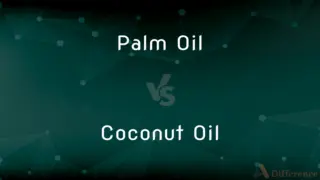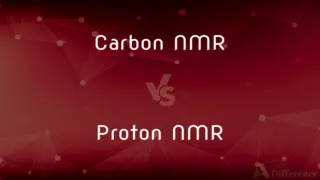Granulated Sugar vs. Regular Sugar — What's the Difference?
By Tayyaba Rehman — Published on November 14, 2023
Granulated Sugar is finely ground, crystallized sugar, while Regular Sugar typically refers to common table sugar, which is often granulated.

Difference Between Granulated Sugar and Regular Sugar
Table of Contents
ADVERTISEMENT
Key Differences
Granulated Sugar is specifically defined by its texture, consisting of small, fine crystals. This type of sugar is designed to dissolve quickly, making it ideal for a wide range of culinary applications. On the other hand, Regular Sugar can be a general term, often referring to the commonly used table sugar which, in many contexts, is indeed granulated.
Both Granulated Sugar and Regular Sugar come from the same sources, either the sugarcane or sugar beet plant. However, the distinction lies in the granularity. Granulated Sugar emphasizes its fine, grainy texture, while Regular Sugar might refer to any commonly used sugar, irrespective of its texture, but is typically granulated in most households.
In recipes, when Granulated Sugar is specified, it's clear that a sugar with fine crystals is required, ensuring a certain consistency and even sweetness. Regular Sugar, however, might need further specification in certain culinary contexts, as its granularity isn't always implicitly understood, though it's often assumed to be granulated.
While Granulated Sugar provides clarity in its name about its texture, Regular Sugar is a broader term. In daily usage, when people refer to Regular Sugar, they often mean the granulated form. However, it's always a good practice to specify the texture, especially in baking where the granularity can affect the outcome.
Comparison Chart
Definition
Sugar with fine, small crystals.
Common table sugar, often granulated.
ADVERTISEMENT
Texture
Fine and grainy.
Depends on context but usually similar to granulated.
Dissolvability
Dissolves quickly.
Generally dissolves easily, especially if granulated.
Usage in Recipes
Specified for even sweetness and consistency.
Can be used interchangeably with granulated, generally.
Common Source
Sugarcane or sugar beet.
Sugarcane or sugar beet.
Compare with Definitions
Granulated Sugar
Granulated Sugar is sugar characterized by fine crystals.
Add a tablespoon of Granulated Sugar to sweeten the sauce.
Regular Sugar
Regular Sugar is the typical sugar used in general culinary applications.
If the recipe asks for Regular Sugar, it usually means granulated.
Granulated Sugar
Granulated Sugar is sugar processed to have small, uniform crystals.
Sprinkle some Granulated Sugar on top for added crunch.
Regular Sugar
Regular Sugar is the sugar commonly used for sweetening foods and drinks.
Can I have some Regular Sugar for my oatmeal?
Granulated Sugar
Granulated Sugar refers to the refined sugar with fine granules.
For a smooth texture, use Granulated Sugar in your drink.
Regular Sugar
Regular Sugar is the standard table sugar found in most households.
Pass the Regular Sugar, please.
Granulated Sugar
Granulated Sugar is the fine-textured sugar often used in baking.
The cookie recipe calls for a cup of Granulated Sugar.
Regular Sugar
Regular Sugar refers to the common sugar used for everyday purposes.
I sweetened my coffee with some Regular Sugar.
Granulated Sugar
Granulated Sugar is a commonly used sugar with a grainy texture.
Ensure the Granulated Sugar is fully dissolved in the mixture.
Regular Sugar
Regular Sugar denotes the everyday sugar with no specific granularity.
Regular Sugar works well for most baking needs.
Common Curiosities
Can I use Granulated Sugar in place of Regular Sugar in recipes?
Yes, since Regular Sugar is typically granulated in many contexts, they can often be used interchangeably.
How does Regular Sugar differ from Granulated Sugar?
Regular Sugar is a general term for common table sugar, which is often granulated, while Granulated Sugar specifies fine texture.
Is there a taste difference between Granulated Sugar and Regular Sugar?
No, the difference lies in texture, not taste.
How is Granulated Sugar produced?
It's derived from sugarcane or sugar beet and refined to have fine crystals.
What is Granulated Sugar?
Granulated Sugar is sugar with small, fine crystals, designed to dissolve quickly.
Why is Granulated Sugar preferred in baking?
Its fine crystals ensure even sweetness and consistency in baked goods.
What do people generally refer to as Regular Sugar in households?
In many households, Regular Sugar typically refers to the granulated form commonly used.
Can I use Regular Sugar for caramelization?
Yes, especially if the Regular Sugar in context is granulated, it caramelizes well.
What should I do if a recipe calls for Regular Sugar and I have various types?
It's often safe to assume granulated, but if granularity affects the outcome, consider clarifying or using Granulated Sugar.
Are there different grades of Granulated Sugar?
Yes, granularity can vary, but standard Granulated Sugar has a consistent fine texture.
How do I store Granulated Sugar?
In a cool, dry place in an airtight container to prevent clumping.
Does Regular Sugar only come from sugarcane?
No, Regular Sugar can come from both sugarcane and sugar beets.
Can I use Granulated Sugar for making syrup?
Yes, its fine crystals make it ideal for dissolving into syrups.
Which is more popular in commercial products, Granulated Sugar or Regular Sugar?
Both are popular, but Granulated Sugar is often preferred for its consistent texture and quick dissolving properties.
Is there a difference in health effects between Granulated Sugar and Regular Sugar?
Both are forms of sucrose and have similar health effects when consumed in excess.
Share Your Discovery

Previous Comparison
Palm Oil vs. Coconut Oil
Next Comparison
Carbon NMR vs. Proton NMRAuthor Spotlight
Written by
Tayyaba RehmanTayyaba Rehman is a distinguished writer, currently serving as a primary contributor to askdifference.com. As a researcher in semantics and etymology, Tayyaba's passion for the complexity of languages and their distinctions has found a perfect home on the platform. Tayyaba delves into the intricacies of language, distinguishing between commonly confused words and phrases, thereby providing clarity for readers worldwide.












































